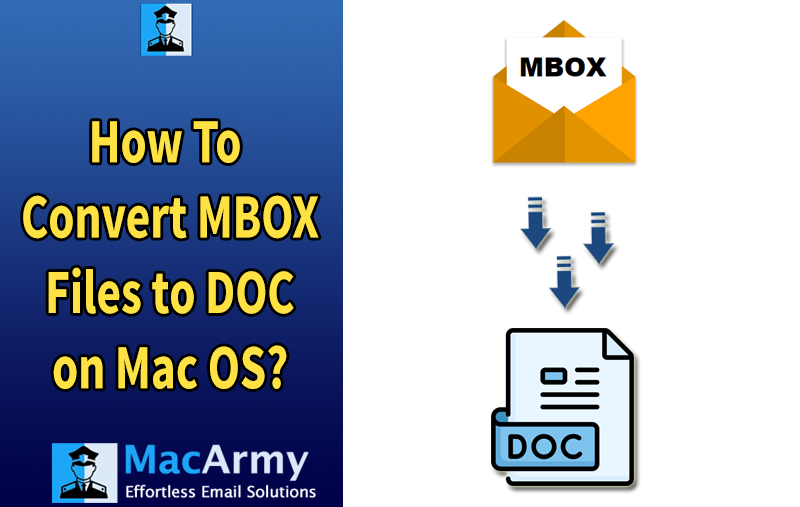How to Convert MBOX to DOC/DOCX Format on Mac OS?

MBOX files are widely supported by many email services but don’t allow users to edit or format the emails directly. To make changes, you need to convert MBOX files into an editable format like DOC. If you’re unsure how to do this, this blog will guide you through the process. By the end, you’ll know how to quickly and easily convert MBOX to DOC files.
Why Convert MBOX Emails to DOC Format?
Many users seek to convert MBOX emails into document formats like DOC because of the clear advantages DOC files offer over MBOX files:
- Easy Sharing: DOC files can be effortlessly shared through various messaging apps like Facebook, WhatsApp, Telegram, Skype, and more.
- Wide Accessibility: MS Word documents can be opened and accessed easily across numerous text programs and devices.
- Simple Editing: DOC files allow users to edit content freely and insert additional elements such as images, tables, and comments.
- Compact and User-Friendly: DOC files are generally smaller, lightweight, easier to read, and simple to copy from anywhere.
These benefits make DOC a much more flexible and convenient format for managing and working with email content.
Expert Solution to Convert MBOX Emails to DOC
Currently, there isn’t a free tool available for converting MBOX files to DOC on Mac. If you need to export MBOX emails to Word documents, the best option is to use a reliable email file converter designed for Mac OS. The MBOX Converter software offers a straightforward and user-friendly interface, making the conversion process simple and efficient. It supports MBOX files from various email clients including Gmail, Apple Mail, Thunderbird, Opera Mail, and more, providing a seamless way to convert your mailboxes directly into editable Word documents.
You can try the software with a free trial version available here:
How to Export MBOX Files to Word Documents
Follow these simple steps to convert your MBOX emails to DOC format:
- Download and install the MBOX to DOC Converter, then launch it.
- Click the Add button to import a single MBOX file or multiple mailboxes at once.
- Hit the Next button to continue.
- Choose DOC as the saving option for the output format.
- Pick your preferred destination folder and select a file naming pattern for the converted files.
- Click the Export button to begin the live conversion process.
- Once finished, the folder containing the newly created DOC files will open automatically on your screen.
That’s it! Your MBOX emails are now converted and ready to use in Word format.
Benefits of Using the MacArmy MBOX to DOC Converter
The MacArmy MBOX to DOC Converter offers a comprehensive and reliable solution for converting MBOX emails into editable Word documents. Here are some detailed features that make this tool stand out and deliver the desired results efficiently:
- Direct and Efficient Conversion: The software enables you to convert multiple MBOX emails directly into DOC format with ease, eliminating the need for complicated manual processes. This ensures a fast and streamlined workflow, saving time and effort.
- Selective and Batch Conversion Support: Whether you want to convert a few specific emails or an entire batch of MBOX files, this tool accommodates both needs. You can handpick individual files or add multiple mailboxes at once, giving you flexibility and control over the conversion process.
- Handles Files of Any Size Without Limitations: Unlike many other tools that impose size restrictions, MacArmy’s converter allows you to add MBOX files regardless of their size. This is especially useful for users with large mailboxes who want to convert extensive email archives without interruptions or failures.
- Dual Methods to Add MBOX Files for Batch Conversion: The software provides two different options for importing files, making batch conversion simple and adaptable to different user preferences. This dual approach enhances usability, ensuring that you can quickly load and process multiple MBOX files simultaneously.
- Preserves Data Integrity and Metadata: Maintaining the original structure and details of your emails is crucial, especially for professional or legal purposes. This converter ensures that all email data, including sender/recipient details, timestamps, attachments, and other metadata, remains intact and unaltered throughout the conversion.
Additional Benefits Mac MBOX to Word Converter
- No Dependency on External Applications: The MacArmy MBOX to DOC for Mac tool operates independently, requiring no additional software like email clients or plugins to perform the conversion. This standalone functionality means you can convert MBOX files to DOC quickly without any extra installations or configurations.
- User-Friendly Interface Designed for Ease of Use: Featuring an intuitive and simple graphical user interface, the tool is designed for users of all technical levels. Clear instructions and easily navigable menus make the conversion process straightforward, even for beginners.
- Cross-Platform Compatibility: Though optimized for Mac OS, the software supports MBOX files generated from various email clients, including Gmail, Apple Mail, Thunderbird, Opera Mail, Entourage, Eudora, Google Takeout, etc. This broad compatibility ensures that users from different platforms can benefit from the converter.
These extensive features combine to make the MacArmy MBOX to DOC Converter a powerful, flexible, and trustworthy solution for converting your MBOX email files into editable and shareable Word documents.
Final Verdict
In this article, we’ve provided a comprehensive solution for effortlessly converting MBOX files to DOC format. If you need to convert multiple mailbox data items into editable MS Word documents, the recommended tool is the ideal choice. It not only supports smooth conversion of MBOX files to DOC but also offers the option to export MBOX emails to PDF format on Mac without any hassle. Additionally, the software is compatible with various MS Word versions, including 2019, 2016, 2013, 2011, 2010, and earlier editions, ensuring seamless access to your emails in Word across different platforms and versions.
